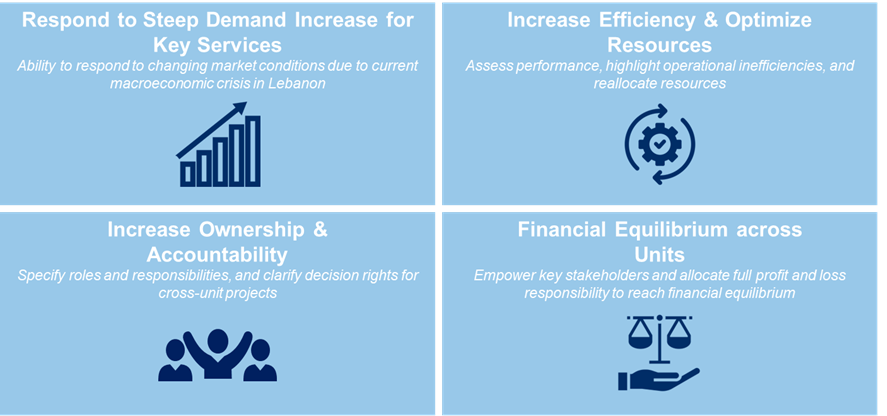Project Brief: Creating a Sustainable Economic Stabilization Model for a Lebanese Social Enterprise
1. Project Context
Over the past 2 years, Lebanon has suffered the consequences of 3 major crises that have each presented a set of macro-economic challenges: political, economic and financial crisis, and humanitarian. The 3 crises had a multiplier effect following the Beirut Blast explosion on August 4, 2020.
o The major intake from the political crisis is that international donors are looking into financing reputable NGOs versus financing public actors directly because of the political mistrust and weak governance
o The main intake from the economic and financial collapse is that the Lebanese Pound lost 14 times its purchasing power from 2 years until now; at the start of the crisis it was 1,500 LBP/USD and today it is over 20,000 LBP/USD. This collapse is also happening in parallel with the insolvency of the central bank and the commercial banks. The value of Lebanese peoples’ incomes and their reserves are getting destroyed, and a fresh start is needed
o On the humanitarian front, a major brain drain is underway for the short-term and medium-term. Another major issue is that more than 50% of the population is heading below the poverty line
These trends; currency devaluation, loss of resources, and brain drain, will worsen with time and contribute to the deterioration of Lebanese businesses’ economic model. In particular, for social enterprises in Lebanon that rely on key policy drivers, these issues will have a difficult and long-term impact on their business model.

Fig. 1: Policy framework for social enterprises, Euromena Consulting analysis
Euromena Consulting has therefore worked directly with one of Lebanon’s most well-known social enterprises to address the need to have a long-term fix by defining a transformation plan for the organization to sustain its activities.
2. Client Overview
This partner organization is a recognized pillar of social action for the most vulnerable populations in Lebanon. Founded in 1985, the organization addresses deficiencies in the state and public services and is one of the executing agencies of the Ministry of Social Affairs (MoSA). As a non-profit organization with over 500 employees, their objectives are focused on three verticals: socio-cultural, economic, and environmental.
3. Project Objective
The primary objective of this project was to respond to the current challenges encountered by designing and implementing a transformation plan to ensure the organization’s sustainability while preserving its objectives and mission. The Euromena Consulting team is therefore helping the client to optimize their internal organization by achieving the following objectives to impact and better more lives, and sustain its operations:
o Respond to the steep demand increase for services and maximize the reach of their welfare and humanitarian programs
o Increase efficiency & optimize resources
o Increase ownership & accountability
o Attain financial equilibrium across units

Fig. 2: Strategic priorities articulation, Euromena Consulting analysis
4. Project Methodology and Results
The intervention focused on 5 main pillars to achieve the project’s objectives:
a) Conducted PMO for four funded activities by an international donor, by following up on execution progress, ensuring achievement of set KPIs, providing mitigation plans, and resolving conflicts when needed
b) Designed best-fit organization structure by focusing on accountability and reward schemes, decision matrix, and reporting;
- Consolidated different units under two entities (welfare entity and for-profit with purpose entity) that serve a common mission and complement each other to sustain activities, based on a benchmark analysis vis a vis international social enterprises. Different business and operating models were identified for each entity
- Met with over 40 stakeholders spread across chiefs of departments, chiefs of programs, chiefs of centers, and chiefs of units
- Designed the best-fit organization structure by conducting a deep-dive analysis, addressing the current imperatives, and selecting optimal option(s) for 10 key organizational strategic and operational design premises: structural orientation, senior oversight, business units’ role, centers’ role, programs’ role, business support contribution, financial management function, PMO position, RelEx position, M&E role
- Defined the governance and modus operandi of the new organizational structure by elaborating the functional statements of all functions in L1, L2, and L3 levels of the organizational structure, and assigning reporting lines and decision rights
- Assigned responsibilities for key cross-functional processes derived from the new organizational structure by following the RACI matrix
- Set a time-bounded change management action plan complemented with a set of KPIs for implementation monitoring
The new organizational structure enabled the below achievements:
- Human resource optimization
- Ownership and accountability enhancement, ensuring solid coordination in cross-functional projects
- Clear separation between operational and strategic functions
- Defined responsibilities across divisions and streamlined reporting
- Institutionalization of workflow processes and procedures
- Decentralized decision making
- Skillset development based on each function’s role (welfare or for-profit with purpose entity)
- Standardized communication among levels and functions
- Customized training, career development plans, and incentive schemes at the organizational and individual levels based on performance
c) Developed a financial and operational model at the unit/activity level following a bottom-up approach to have visibility over resources, synergies, inefficiencies, and opportunities. The objective is to attain financial equilibrium across units.
d) Assessed current communication strategy and department and provided recommendations to improve performance in terms of branding and marketing based on best practices and benchmark
e) Based on the new organizational structure, prescribed a new legal set-up for different entities
Project Team:
Elie Baho, Manager
Celine Khalil, Senior Consultant
Ramy Frangieh, Consultant